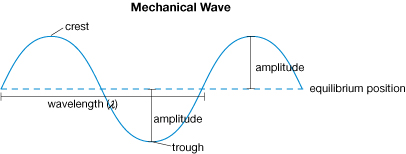Module 8—Mechanical Waves
 Explore
Explore

© Trout55/shutterstock
This photo is a close-up of a single drop of water landing on a smooth water surface. (The three droplets just above the surface were splashed upwards after impact.) From the point of impact at the centre, waves radiate outwards in all directions, travelling with a constant speed. Here, the water is the medium in which the wave energy moves as it disturbs the water surface from its equilibrium position. Surrounding the point of impact, there are regions where the water’s surface is higher than the equilibrium position. These regions are called crests. In other regions, the water level is lower than the equilibrium position. These areas are called troughs. The amount of change (up or down) from the equilibrium position is referred to as amplitude. All of these descriptors are illustrated below in the side view of a mechanical wave.
medium: the substance that acts as a carrier for a wave
equilibrium position: the position where the medium would normally rest
crest: the highest point in a wave
trough: the lowest point in a wave
amplitude: the measure of the maximum displacement of a wave from the equilibrium position

wavelength: the distance between consecutive crests (or troughs)
point source: a source that radiates waves as if it were a point
All periodic waves are defined by having several measurable characteristics. The distance between the centres of consecutive crests and troughs are equal. This is defined as the wavelength (λ), which is also illustrated above. Wavelength may also be defined as the distance between any two particles that are moving in the same direction and have the same displacement from the equilibrium position. The symbol for wavelength is the Greek letter lambda (λ).
The mechanical waves discussed in this lesson require three things: some source of disturbance, a medium that can be disturbed, and some physical connection or mechanism through which adjacent portions of the medium can influence each other. To generate a wave, a point source, such as a water droplet, earthquake, or nuclear explosion, disturbs the medium. The energy of the disturbance is transferred from one point to another as the particles within the medium vibrate with simple harmonic motion. It is the transfer of energy in this manner that creates a mechanical wave that travels or propagates through the medium.
 Watch and Listen
Watch and Listen
Watch the video clip hydrogen bomb blast that shows the circular waves produced by the world’s first hydrogen bomb blast in the Pacific Ocean.
 Read
Read
Read “The Properties of Waves" on pages 394 and 395 of the textbook. Compare the definitions on these pages with those you have already encountered in this lesson.
 Module 8: Lesson 1 Assignment
Module 8: Lesson 1 Assignment
Remember to submit the answer to TR 1 to your teacher as part of your Module 8: Lesson 1 Assignment.
 Try This
Try This
TR 1. Define the following terms with the aid of your physics textbook.
- wave
- wave front
- medium
- incident wave
- reflected wave
- wave train
 Read
Read
Read “Waves and Rays" on pages 397 to 399 of your textbook.
 Self-Check
Self-Check
SC 1. Define a wave ray.
SC 2. When a wave front from a point source reflects off a straight barrier, where does the reflected wave appear to originate?
SC 3.
- When a straight wave front from a straight wave generator reflects off a straight barrier, where does the reflected wave appear to originate?
- What is the angle of reflection?
 Self-Check Answers
Self-Check Answers
SC 1. A wave ray is a line indicating the direction of motion of the wave front at the point where the ray intersects the wave front.
SC 2. The reflected wave appears to have originated from an imaginary point source exactly the same distance behind the barrier as the actual source is in front of it.
SC 3.
- The reflected wave appears to have originated from an imaginary straight wave generator exactly the same distance behind the barrier as the actual source is in front of it.
- The angle between the reflected wave front and the barrier will have the same value as the angle between the incident wave front and the barrier.